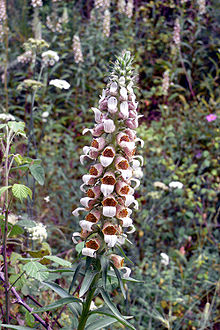| Digitalis lanata | |
|---|---|

| |
| flowering in situ on the island of Thasos, Greece | |
| Scientific classification | |
| Kingdom: | Plantae |
| Clade: | Tracheophytes |
| Clade: | Angiosperms |
| Clade: | Eudicots |
| Clade: | Asterids |
| Order: | Lamiales |
| Family: | Plantaginaceae |
| Genus: | Digitalis |
| Species: | D. lanata
|
| Binomial name | |
| Digitalis lanata | |
| Synonyms[2] | |
Digitalis lanata, vernacularly often called woolly foxglove[3] or Grecian foxglove,[4] is a species of foxglove, a flowering plant in the plantain family Plantaginaceae. It gets its name due to the woolly indumentum of the leaves. D. lanata, like other foxglove species, is toxic in all parts of the plant. Symptoms of digitalis poisoning include nausea, vomiting, severe headache, dilated pupils, problems with eyesight, and convulsions at the worst level of toxicity. The plant is also harmful to other animals.[5][6]
- ^ "Digitalis lanata". International Plant Names Index. The Royal Botanic Gardens, Kew, Harvard University Herbaria & Libraries and Australian National Botanic Gardens. Retrieved 30 November 2020.
- ^ "Digitalis lanata Ehrh". Plants of the World Online. Royal Botanic Gardens, Kew. 2017. Retrieved 30 November 2020.
- ^ Elizabeth A. Dauncey; Sonny Larsson (6 March 2018). Plants That Kill: A Natural History of the World's Most Poisonous Plants. Princeton University Press. pp. 199–. ISBN 978-0-691-17876-9.
- ^ "Grecian Foxglove". Biological Control and Eradication Projects. Kansas Department of Agriculture. 2006. Archived from the original on 2010-08-24. Retrieved 2010-05-06.
- ^ "Grecian foxglove (Digitalis lanata)". Terrestrial invasive species. Minnesota Department of Natural Resources. 2020. Retrieved 6 December 2020.
- ^ Marhold, Karol (2011). Greuter, Werner; von Raab-Straube, E. (eds.). "Details for: Digitalis lanata". Euro+Med Plantbase. Botanic Garden and Botanical Museum Berlin-Dahlem. Retrieved 30 November 2020.